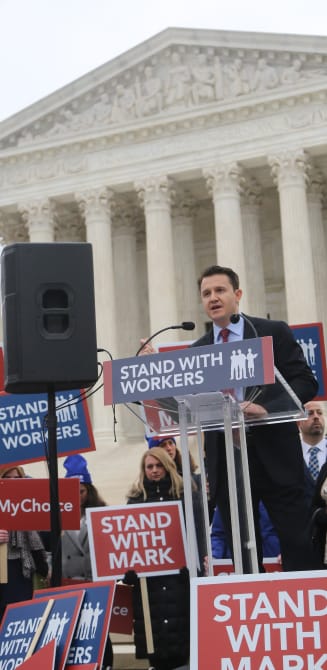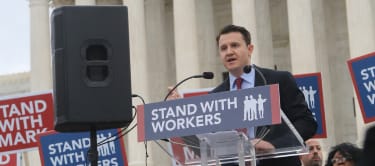by Jacob Huebert
February 22, 2019
In last year’s Janus v. AFSCME decision, the U.S. Supreme Court ruled that the
First Amendment forbids governments from requiring their employees to pay fees
to a union. As a result, some five million government employees across 22
states who previously had to give part of every paycheck to a union are now
free to choose which organizations they will and won’t support with their
money.
But the Janus
decision onlyended those forced
fees. It didn’t stop public-sector unions from “representing” workers who
aren’t union members and don’t want a union to speak for them.
Now, a case
brought by the Buckeye Institute is asking the Court to take that next step and
strike down laws that authorize government bodies to recognize a union as
employees’ “exclusive representative.” The plaintiff, Minnesota professor
Kathleen Uradnik, argues that appointing a union to speak to the government on
her behalf—even though she disagrees with many positions the union takes and
would prefer to speak for herself—violates her First Amendment right to freedom
of association.
Uradnik has reasons to be optimistic about
her case. In Janus, the Court
suggested it might be open to her argument when it described unions’ power of
exclusive representation as “a significant impingement on associational
freedoms that would not be tolerated in other contexts.”
The Goldwater Institute has filed an amicus
brief asking the Court to hear Uradnik’s case. We argue that
exclusive-representation laws not only violate employees’ First Amendment
rights but also create super-powered “factions” that undermine our republican
system of government.
The Founders used the term “factions” to refer
to groups that would use the government to serve their own interests rather
than the public interest. The Founders expected that, in a large and
diverse republic such as ours, the many factions competing with each other in a
system governed by checks and balances would prevent each other from obtaining
too much power.
Today, public-sector unions are a prominent
example of a faction: They seek to use the government to enrich themselves and
(at least some of) their members at others’ expense. But they aren’t
constrained by our system of government as a typical faction is, for several
reasons.
For one, unlike other groups, public-sector
unions can force the government to the bargaining table and compel officials to
negotiate with them—typically behind closed doors, with no outsiders or
dissenting employees there to present competing views.
And if unions don’t get what they want in
bargaining, they can hold the public hostage by striking. That’s why even the
union-friendly President Franklin Roosevelt believed unions didn’t belong in
government. “The desire of Government employees for fair and adequate pay,
reasonable hours of work, [and] safe and suitable working conditions” was
legitimate, he wrote in a famous letter, but differences
between public-sector and private-sector employment imposed a “distinct and
insurmountable limitation[]” to the use of collective bargaining in government.
“Militant tactics,” Roosevelt wrote, “have no
place in the functions of any Government employees” because government
employees are supposed to “serve the whole people” rather that employees’ own
private interests. For a labor organization of government employees to take
action against a government employer would be “unthinkable and intolerable,”
according to Roosevelt, because it would “look[] toward the paralysis of
Government by those who have sworn to support it.”
Today, of course, public-sector employees can
and do strike, often causing great disruption to people who count on public
services. Sometimes these strikes are authorized by law, and sometimes
government employees strike even where it’s against the law, as with the recent
illegal Arizona teacher strike.
But typically unions don’t have to strike to
get their way. Through heavy political activity, they help choose the officials
they negotiate with—effectively putting themselves on both sides of the
bargaining table. And not only can union-backed officials give in to unions’
demands for more government spending; they also can authorize unionization of
additional government employees, thereby delivering more union members and even
more money to fuel unions’ political agenda. In this way, unions become
political perpetual-motion machines, funded by taxpayer money to demand even
more taxpayer money for the union and its members.
Because of their unique privileges,
public-sector unions in many places haven’t been reined in by the majority or
counteracted by other factions competing for power. That’s one reason why
salaries and pension benefits demanded by unions now overwhelm the budgets of states such as Illinois.
That’s by design. Evading our system’s
natural constraints on factions—that is, obtaining more taxpayer money for
government unions and employees than they could obtain through the democratic
process alone—is the avowed purpose of
public-sector collective bargaining.
Eliminating public-sector unions’ power of
exclusive representation would reduce government unions to the kinds of
factions the Founders anticipated in designing the Constitution—still
dangerous, but limited by the political process. The Supreme Court should
therefore hear Kathleen Uradnik’s case, both to protect her First Amendment
rights and to ensure that the problem of faction will be duly curbed as the
Founders intended.
Jacob Huebert is
a Senior Attorney at the Goldwater Institute. He was part of the team that
litigated Janus v.
AFSCME.









